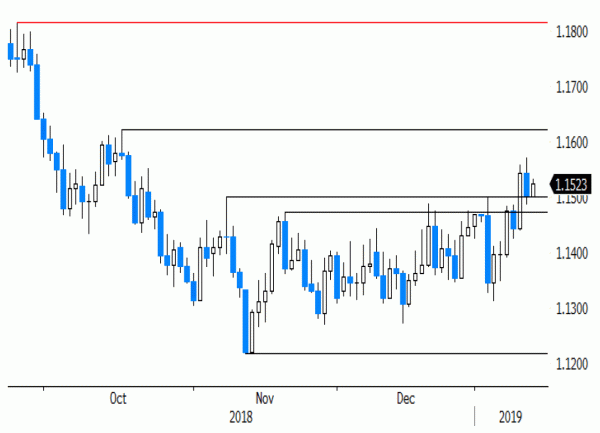- Rates: US CPI and Italian supply in focus
US Treasuries underperformed during yesterday’s US session as stock markets recovered from opening weakness and after a soft 30-yr bond sale. Soft US CPI readings and cautiousness about President Trump’s reaction function in the border funding debate might cause outperformance of US T’s today. First Italian supply of the year is expected to be well digested. - Currencies: Will USD suffer further losses from CPI?
The USD decline slowed yesterday, at least temporarily. Still, EUR/USD sustained north of 1.15 as Fed speakers confirmed a wait-and-see approach. Today, the focus is on the US December CPI. A slowdown in headline inflation might comfort markets to continue recent repositioning away from the dollar.
The Sunrise Headlines
- US equity markets gained modest ground yesterday, recovering from opening weakness. The first HY bond deal in 40 days supported sentiment. Asian equities trade mixed this morning with Japanese and Chinese indices all reaping profits.
- US President Trump cancelled his trip to the World Economic Forum later this month in Davos (Switzerland), as the partial government shutdown keeps US politics in deadlock. The shutdown enters its 21th day.
- US Fed chairman Powell reiterated that the central bank can apply a more flexible approach while it’s assessing the impact of economic conditions. VP Clarida added it might alter its balance sheet normalization process if necessary.
- Steven Mnuchin, US Treasury secretary, told that Liu He, Chinese VP, is most likely to visit Washington later this month to continue US-Sino trade talks after three days of negotiations concluded on Wednesday.
- The Chinese renminbi advanced 1.7% so far this week against the US dollar, its best week since 2005, when China left its currency peg and changed to a floating exchange rate regime. USD/CNY currently trades below 6.78.
- Australian retail sales rose 0.4% (M/M) in November, more than the month before (0.3%) and market expectations (0.3%). The Australian dollar gained this morning, but partially on overall US dollar softness.
- Today’s economic calendar is very meagre, with in the US only CPI data for December lining up. The UK publishes some second-tier data, while the Italian government taps the bond market for the first time this year
Currencies: Will USD Suffer Further Losses From CPI?
Soft US inflation to inspire further USD decline?
The USD decline slowed yesterday, at least temporarily. The risk rebound, which was at least partially correlated with a weaker dollar, also shifted into a lower gear. Fed governors, including Chairman Powell reiterated that the Fed can be patient and monitor the data in order to see whether it is still appropriate to raise rates further. The comments had little direct impact on US yields or on the dollar. Both continued a technical intraday rebound. Sentiment on risk improved again later in US dealings. EUR/USD closed exactly at 1.1500 (from 1.1543). USD/JPY also gained modestly (108.43 vs 108.17). This morning, most Asian equity markets are again in positive territory. The pace of the CNY rebound (USD/CNY 6.75 area) is catching the eye. The yuan profits from an overall softer dollar and is supported by investor hopes on easing trade tensions between the US and China. Australian equities underperform as the Aussie dollar strengthens (AUD/USD > 0.72). The US dollar remains in the defensive overall. EUR/USD is trading in the 1.1530 area. USD/JPY (108.20) is also under slight pressure even as risk sentiment remains constructive. The December US CPI takes centre stage today. A soft inflation context currently justifies the Fed’s softer wait-and-see approach. Consensus expects headline inflation to ease from 1.9%. Core inflation is expected unchanged at 2.2%. The risks headline inflation are probably to the downside (oil prices). A figure in line or softer than expected will comfort markets on the softer Fed approach and might be inspire further USD selling. This is our preferred scenario. On the other hand, an upward surprise of (core) inflation, might wrong-foot (FX) markets. Since end last week, the dollar lost momentum and EUR/USD clearing a first technical barrier (1.15). We had a cautious bias on the US dollar as it became clear that the USD will get little interest rate support in the foreseeable future. For now, we see no reason to row against the USD negative momentum. EUR/USD 1.1621 (mid-Oct top) is next reference.
EUR/GBP hovered the 0.90 big figure yesterday. The UK currency remains hostage to the ever growing political uncertainty in the run-up to Tuesday’s ‘meaningful vote’. At some point, this process might lead to a Brexit delay or another scenario that might be considered more favourable for sterling. However, short term, visibility on the next Brexit steps remains close to non-existent. This might continue to weigh on sterling. EUR/GBP 0.91 is the next technical reference.
EUR/USD holding north of 1.15 as Fed confirms wait-and-see approach













